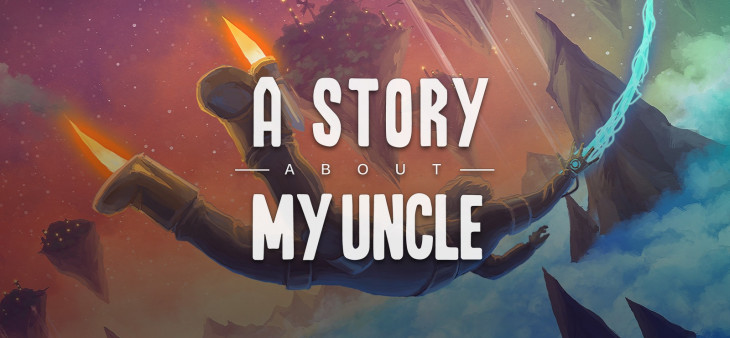
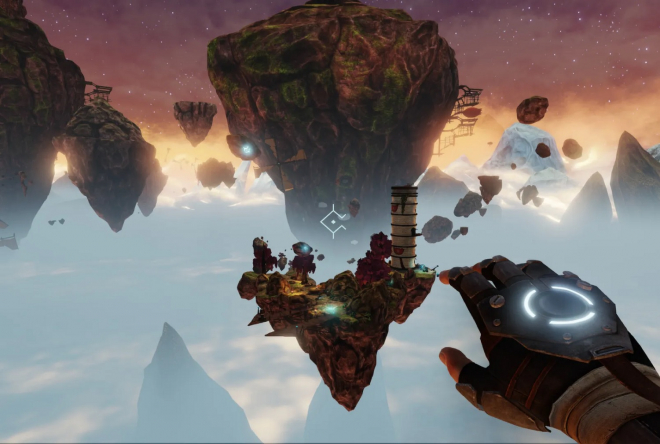
How I Discovered This Game (In a Pretty Unusual Way)
It’s funny how sometimes we stumble upon a game in the most unexpected ways. I first came across A Story About My Uncle not through reviews, recommendations, or even gameplay videos, but through something completely unrelated—drama and critique channels on YouTube.
You know the type: long-form videos analyzing controversies, industry failures, or deep dives into niche internet topics. The content itself wasn’t about the game, but in the background, behind the narrator’s voice, there was always something that caught my attention—gameplay footage of a character soaring through the air, swinging from glowing grappling beams, navigating floating islands with impossible grace. I had no idea what the game was called, but the way that hand with the glowing gauntlet latched onto structures and pulled the player forward, letting them swing and launch themselves through the air, was mesmerizing. It was hypnotic to watch, and I found myself paying more attention to the gameplay than to whatever the video was actually talking about.
Eventually, curiosity got the better of me. I paused the video, scrolled down to the comments, and found what I was looking for: A Story About My Uncle. A quick search later, I saw that it was a first-person adventure platformer with a strong focus on movement, and that was all I needed to play it.
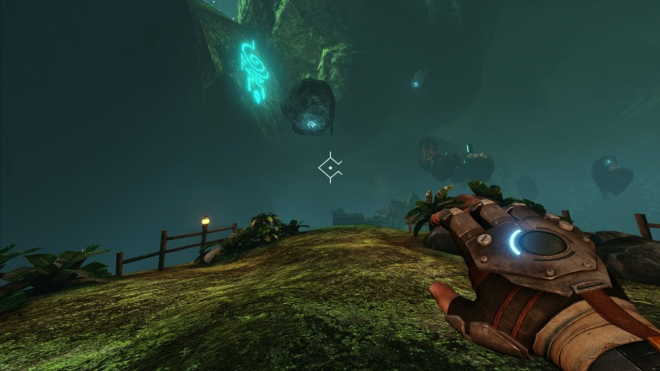
The Core Experience – A Game About Momentum
There’s a story in A Story About My Uncle, of course. The game follows a boy searching for his missing uncle, leading him to a strange world filled with floating islands, mysterious ruins, and frog-like humanoid creatures. But let’s be honest—the real star here is the gameplay.
The game is, at its heart, about movement. You’re given a high-powered grappling glove that lets you latch onto surfaces and swing across massive chasms, and this mechanic alone makes the entire experience feel exhilarating. Unlike most platformers, where jumps are predictable and rigid, here you have complete control over how you build momentum. You can launch yourself forward, adjust your trajectory mid-air, and time your swings perfectly to maintain speed.
And when you master it? That’s when the magic happens.
There’s a moment in this game when everything just clicks—when you stop overthinking, stop hesitating, and just flow. You start chaining jumps effortlessly, using the environment like an extension of yourself, swinging from cliffs, rebounding off glowing energy pads, and launching yourself through intricate platforming sequences with a level of fluidity that few games manage to achieve. The best part? It feels incredibly rewarding. There’s a real sense of skill involved, and when you pull off a perfect sequence of movements, you feel like you’re flying.
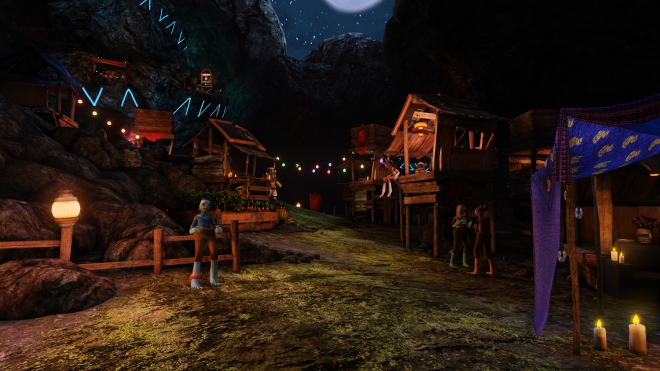
The Frog People Village – A Magical Moment
Of all the locations in the game, the one that stood out to me the most was the village of the frog people. Up until that point, the game had been an otherworldly but relatively lonely experience—jumping through vast, empty spaces, feeling small in the face of the enormous floating landscapes. But then you arrive at this warm, glowing village, nestled within the rocks, filled with life and culture.
It’s a simple place, but it has so much personality. There are little glowing lights, rustic wooden bridges, and structures that look both handmade and impossibly advanced at the same time. The frog people themselves, while not incredibly deep as characters, give the world a sense of warmth. It was the first moment in the game where I felt like I wasn’t just passing through—I was visiting somewhere real.
This section of the game also feels like a turning point. The adventure truly begins to feel like a journey, rather than just a set of platforming challenges. There’s a sense of mystery, wonder, and excitement that reminded me of old fantasy tales—the kind of stories where a young protagonist stumbles into an unknown world and is swept away into something greater than themselves.
Visuals and Atmosphere – Not the Most Advanced, But Striking Nonetheless
From a purely technical perspective, A Story About My Uncle isn’t graphically groundbreaking. The textures can be a little simple, and the character models aren’t anything to write home about. But what it lacks in raw graphical power, it more than makes up for in artistic direction.
The game’s environments have a dreamlike quality, filled with floating landmasses, glowing crystals, and vast skies that stretch endlessly in every direction. The use of lighting, in particular, is fantastic—glowing blues, deep purples, and warm golds make each area feel distinct and inviting. It feels like stepping into a fantasy painting, where everything is designed to be more about emotion than realism.
And that works perfectly for a game like this. You don’t need hyper-detailed textures when the world itself is so atmospheric and visually compelling.
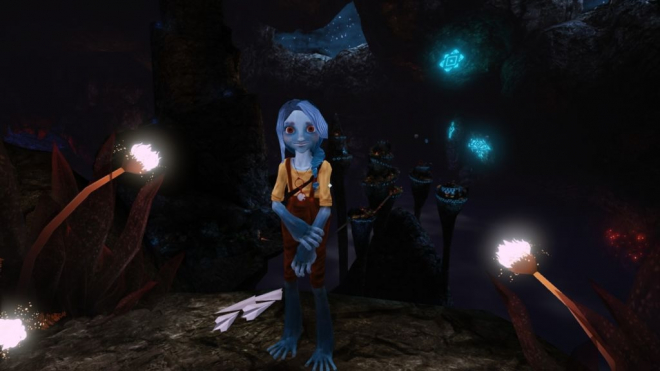
Sound & Music – Enhancing the Journey
The sound design in A Story About My Uncle is subtle but effective. The way the wind rushes past as you swing through the air, the metallic hum of your grappling glove charging up, and the soft, ambient sounds of the world add to the immersion.
The music, while not overly complex, fits the game’s mood well. It’s a mix of soft, ambient tracks that create a sense of mystery and wonder. There are moments of near silence, allowing the soundscape to take over, making every leap and every swing feel more impactful. It’s not a soundtrack you’ll find yourself humming later, but it serves the game’s atmosphere beautifully.
A Story That’s Nice, But Not the Main Attraction
The story in A Story About My Uncle is sweet, but secondary. The game is framed as a bedtime story, told by an older man to his child, reminiscing about his journey to find his uncle. There’s a sense of nostalgia and wonder in the way it’s presented, and while it’s a charming narrative device, it never really takes center stage.
The game introduces characters like Madeline, one of the frog people, who helps guide the protagonist, and there are some emotional beats along the way. But ultimately, the plot feels more like a backdrop to the real experience—the adventure itself.
And honestly? That’s fine. Some games are driven by their stories, while others are driven by their mechanics. This is a game about movement, exploration, and momentum, and those aspects shine brighter than anything else.
Summary
A Story About My Uncle is a beautiful, fast-paced platforming experience that shines through its grappling-based movement and fluid traversal mechanics. The story, while nice, takes a backseat to the thrill of swinging through massive floating landscapes. The visuals are artistically striking, the world feels mysterious and inviting, and the gameplay is satisfying and rewarding.

Steam Deck Performance
One of the key aspects of my reviews is testing the actual performance of games on the Steam Deck, rather than simply trusting Steam’s Deck Verified labels. Steam does not always test games thoroughly enough, leading to situations where "Verified" games struggle in late-game sections due to performance drops, while some "Unsupported" titles run perfectly at 60 FPS without modifications. Additionally, some games marked as "Unsupported" actually work flawlessly with a simple community patch or minor tweaks. My goal is not only to evaluate the technical and artistic aspects of the games I review but also to verify the accuracy of these labels and help Steam Deck owners understand whether a game is truly playable or if workarounds exist to make it run smoothly.
For A Story About My Uncle, the Steam Deck delivers a great experience with no major issues. The game runs at a stable 60 FPS with default settings, making it a solid choice for portable play. The gyro aiming function, while not necessary, can be a great addition for those who want more precise control when grappling onto distant objects.
Recommended Settings for Steam Deck:
- Resolution: 1280x800 (native Steam Deck resolution)
- Frame Rate: Stable 60 FPS at default settings
- Graphics Settings: High (game is not very demanding)
- Gyro Aiming: Recommended for precision movement
- Battery Life: Approx. 3-4 hours, depending on settings
Overall, A Story About My Uncle is a fantastic game to play on the Steam Deck, requiring no special tweaks while running smoothly at high settings.
AUTHOR INFORMATION

 The strongest aspect of the game, offering thrilling, skill-based platforming that keeps players engaged.
The strongest aspect of the game, offering thrilling, skill-based platforming that keeps players engaged.
 While not technically impressive, the art direction is beautiful and effective, creating a visually distinct world.
While not technically impressive, the art direction is beautiful and effective, creating a visually distinct world.
 A touching and imaginative tale, though secondary to the gameplay.
A touching and imaginative tale, though secondary to the gameplay.
 A calming and atmospheric soundtrack that enhances the sense of adventure.
A calming and atmospheric soundtrack that enhances the sense of adventure.
 Runs smoothly with no major issues, though gyro aiming is recommended for better accuracy.
Runs smoothly with no major issues, though gyro aiming is recommended for better accuracy.
PROS / CONS
- Incredible movement system – swinging and launching yourself feels amazing.
- Engaging and rewarding gameplay – mastering the momentum is fun.
- Beautiful artistic direction – simple graphics but great atmosphere.
- The frog people village – a standout moment in the game.
- Short length – the game can be completed in a few hours.
- Story is not very deep – charming but not the main draw.
- Some sections can feel frustrating – if you miss a jump, expect to retry.




